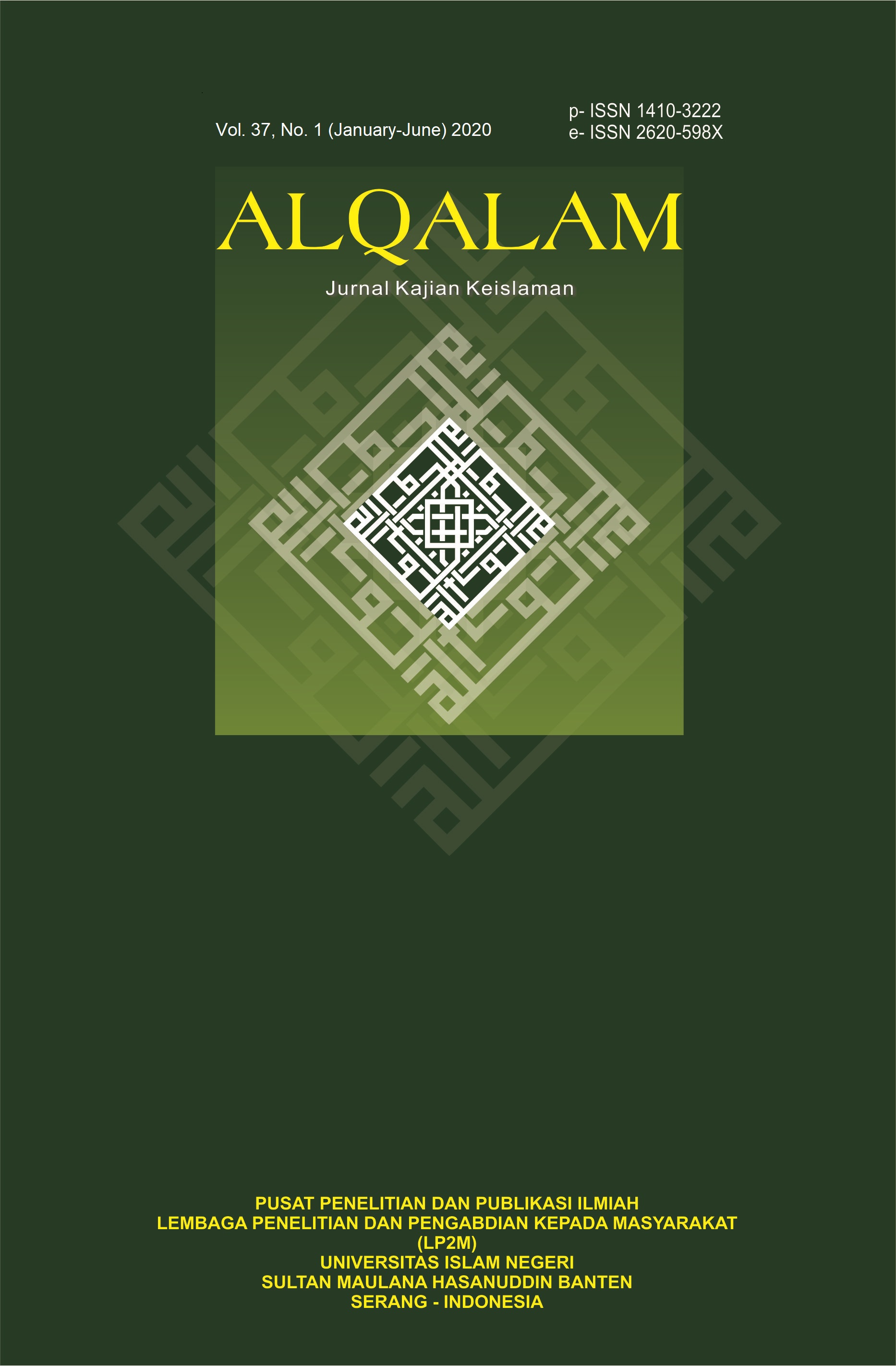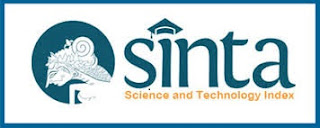The Art of Debating by the Prophet Ibrāhīm: Analysis of Ma'nā cum maghzā's Approach to Q. 2: 258
DOI:
https://doi.org/10.32678/alqalam.v39i1.5591Keywords:
Keywords: Debating, Prophet Ibrāhīm, Ma'nā cum Maghzā, Q. 2: 258.Abstract
This article delves more deeply into the prophet Ibrāhīm's art of debating: an analysis of ma'nā maghzā's approach to Q. 2: 258. The difference of views is a fact that cannot be denied. The debates that occur often lead to the presence of further conflicts, both at the regional, national, and international levels. Two points are outlined, first, how to use Q. 2: 258 in its language and socio-historical manner; Second, what is the significance of Q. 2: 258. This article is a type of qualitative research in the form of library research. The primary data source in this study is Q. 2: 258. While secondary data sources include literature that is directly or indirectly related, both in physical and online libraries. To see it, this article uses the ma'nā cum maghzā approach offered by Sahiron Shamsuddin. As a result, in language, Q. 2: 258 is a verse that specifically speaks to a debate that took place between the Prophet Ibrāhīm and King Namruż. Q. 2: 258 hints at a system of "debate" in the context of "inclusive dialogue". The argument used by the Prophet Ibrāhīm is a type of argument a fortiori, which is an argument that has an analogical affirmation value between two different things but is closely related in a logical corridor.
Downloads
References
Al-Andalusy, I. ‘Athīyyah. (2001). Al-Muḥarrar Al-Wajīz (Jilid I). Dar al-Kutub al-Ilmiyah.
Al-Dzawahiri, K. (1991). Badā’i Al-Idhmār Al-Qaṣaṣi.
Alhassen, L. O. (2017). A Semantic and Thematic Analysis of the Story of Ibrāhīm in the Qur’ān: Family, Parents, and Ancestors. Religion & Literature, 49(3), 49–76.
Ali, H., & Purwandi, L. (2019). Wajah Islam Indonesia. Islami[dot]co.
Al-Mahalli, I. J., & as-Suyuthi, I. J. (n.d.). Tafsir Jalalain. Sinar Baru Algensindo.
Al-Zuhaily. (2009). Tafsīr al-Munīr (Jilid III). Dar al-Fikr.
Anam, A. K., Triana, R., & Zakaria, A. (2019). Debat dalam Prespektif Al-Qur’an: Studi Tematik Ayat-ayat tentang Debat. ProsA IAT: Prosiding Al Hidayah Ilmu Al-Quran dan Tafsir, 1(1), 1–19.
ar-Raghib Al-Ashfahani. (2017). Al-Mufradatu fī Gharīb al-Qur’an (terj: Ahmad Zaini Dahlan). Pustaka Khazanah Fawa’id.
Asfar, A. M. I. (2019). Analisis Naratif, Analisis Konten, dan Analisis Semiotik (Penelitian Kualitatif). https://doi.org/10.13140/RG.2.2.21963.41767
Azwar, S. (2016). Metode Penelitian. Pustaka Pelajar.
BELHAJ, A. (2012). Dialectics of the Qur’ān through Q 2:258. Islamic Studies, 51(3), 263–273.
Bello, M. K.-D., Toure, A. K., & Yusoff, A. M. (2015). The Misconception (Jadal) in Quran. ‘Ūlum Islāmiyyah Journal, 15. http://ddms.usim.edu.my/bitstream/123456789/9830/1/3-ulum%20islamiyyah%2015%20copy.pdf
Bowen, J. R. (1998). Qurʾân, Justice, Gender: Internal Debates in Indonesian Islamic Jurisprudence. History of Religions, 38(1), 52–78.
Friday, J. R. (2013). The Dialogue of Religious Experience: Theory and Practice. New Blackfriars, 94(1051), 278–294.
Gadamer, H.-G., Weinsheimer, J., & Marshall, D. G. (2004). Truth and method (2nd, rev. ed ed.). Continuum. https://mvlindsey.files.wordpress.com/2015/08/truth-and-method-gadamer-2004.pdf
Ghiasi, S., & Far, M. J. (2014). A Descriptive—Analytical Introduction on Way of Debate Methods in Holy Quran (Ethical and linguistic Approach). AENSI Journals, 8(25), 9.
Gordani, N. (2021). Konsep Qudwah Hasanah Dalam Pendekatan Dialog Nabi Ibrahim Berasaskan Ayat-Ayat Dialog Dalam Al-Qur’an. The Sultan Alauddin Sulaiman Shah Journal (JSASS), 8(2), 1–9.
Hitti, P. K. (2006). History of the Arabs (terj: R. Cecep Lukman Yasin dan Dedi Slamet Riyadi). PT SERAMBI ILMU SEMESTA.
Ironi Corona di Mata MUI: Bandara Dibuka, Masjid Ditutup. (n.d.). Retrieved December 27, 2021, from https://www.cnnindonesia.com/nasional/20200517114000-20-504154/ironi-corona-di-mata-mui-bandara-dibuka-masjid-ditutup
Jabal, M. H. (2010). Al-Mu’jam Al-Isytiqāqī Al-Muaṣal (Jilid IV). Maktabatul Adab.
Lanier, J. (2020). Ilusi Media Sosial (terj: Elvan Afiyan Wijaya). Cantrik Pustaka.
Larangan Ke Masjid Selama Pandemi: Kesempatan Menjadikan Rumah Tidak Seperti Kuburan—Cahaya Islam Berkemajuan. (n.d.). Retrieved December 27, 2021, from https://muhammadiyah.or.id/larangan-ke-masjid-selama-pandemi-kesempatan-menjadikan-rumah-tidak-seperti-kuburan/
Lings, M. (2011). Muhammad (terj: Qomaruddin). PT SERAMBI ILMU SEMESTA.
Machendrawati, N., & Asep, K. (2003). Teknik Debat dalam Islam. Pustaka Setia.
Manna’ al-Qaṭṭān. (n.d.). Mabaḥiṣ fī ‘Ulūmul Qur’ān. Maktabah Wahbah.
Marwadi, M. (2008). Argumen a Fortiori dan Argumen a Contrario dalam Hukum Islam dan Hukum Positif. Al-Manahij: Jurnal Kajian Hukum Islam, 2(1), 27–42. https://doi.org/10.24090/mnh.v2i1.3694
McAuliffe (ed.), J. (2003). Encyclopaedia of the Qur’an: Vol. Vol. 3. E.J. Brill.
McAuliffe (ed.), J. D. (Ed.). (2001). Encyclopaedia of the Qurʼān (I). Brill.
Meniadakan Sholat Berjamaah di Masjid Saat Pandemi Berarti Takut Pada Allah—Pedoman Tangerang. (n.d.). Retrieved December 27, 2021, from https://pedomantangerang.pikiran-rakyat.com/religi/pr-072304522/meniadakan-sholat-berjamaah-di-masjid-saat-pandemi-berarti-takut-pada-allah
Milligan, J. A. (1996). Multiculturalism and the Religious Right: Is Dialogue Possible? Journal of Thought, 31(1), 45–54.
Mir, M. (1992). Dialogue in the Qur’an. Religion & Literature, 24(1), 1–22.
Modarressi, H. (1993). Early Debates on the Integrity of the Qur’ān: A Brief Survey. Studia Islamica, 77, 5–39. https://doi.org/10.2307/1595789
Nadia, Z. (2020). Telaah Struktural Hermeneutik Kisah Nabi Ibrahim dalam Al-Qur’an. Mutawatir: Jurnal Keilmuan Tafsir Hadith, 10(1). http://jurnalfuf.uinsby.ac.id/index.php/mutawatir/article/view/1225/1150
Nahrawi, A. (2019). Wacana Debat Inklusif: Menyoal Jadal sebagai Perdebatan dalam Al-Qur’an. Jurnal Al-Ashriyyah, 5(1), 16.
Palmer, R. E. (1969). Hermeneutic Interpretation Theory in Schleimacher, Dilthey, Heidegger, and Gadamer. Northwestern University Press.
Prager, D. (1991). How Can a Religious Person Tolerate Other Religions? Dialogue: A Journal of Mormon Thought, 24(2), 11–23.
Rahman, F. (1982). Islam and Modernity Transformation of an Intellectual Tradition. The University of Chicago Press.
Shihab, M. Q. (2009). Tafsir al-Misbah: Vol. Volume 1. Lentera Hati.
Sholeh, K. H. Q., & Dahlan, H. A. A. (2000). Asbāb An-Nuzūl: Latar Belakang Historis Turunnya Ayat-ayat Al-Qur’an (Edisi Kedua). Penerbit Diponegoro.
Simanjuntak, B. A., & Sosrodiharjo, S. (2014). Metode Penelitian Sosial (Edisi Revisi). Yayasan Pustaka Obor Indonesia.
Sinn, S., El Omari, D., Grung, A. H., & Lutheran World Federation (Eds.). (2017). Transformative readings of sacred scriptures: Christians and Muslims in dialogue. Evangelische Verlangsanstalt GmbH: The Lutheran World Federation. https://www.lutheranworld.org/sites/default/files/2017/transformative_readings_of_sacred_scriptures-en.pdf
Syamsuddin (ed.), S. (2020). Pendekatan Ma’nâ-Cum-Maghzâ atas Al-Qur’an dan Hadis: Menjawab Problematika Sosial Keagamaan di Era Kontemporer. Asosiasi Ilmu Al-Qur’an dan Tafsir & Lembaga Ladang Kata.
Syamsuddin, S. (2017). Hermeneutika dan Pengembangan Ulumul Qur’an (Edisi Revisi dan Perluasan). PESANTREN NAWESEA PRESS.
Talbi, M. (1992). ’Iyal Allah. Saras li-I-Nasyr.
Toriyono, M. D. (2021). Dialog Argumentatif Nabi Ibrahim dan Raja Namrud dalam Perspektif Al-Qur’an. Al-Dikhra, 3(2), 14.
Viral, Pengurus Masjid di Bekasi Usir Warga Yang Salat Pakai Masker. (n.d.). Retrieved December 27, 2021, from https://www.jawapos.com/jabodetabek/03/05/2021/viral-pengurus-masjid-di-bekasi-usir-warga-yang-salat-pakai-masker/
War’i, M. (2019). Dialog Inklusif: Dari Kebenaran Subjektif Menuju Kebenaran Objektif (Tinjauan Semiotik-Hermeneutik Al-Quran Surat Al-Baqarah Ayat 30-33). Dialog, 42(1), 21–38. https://doi.org/10.47655/dialog.v42i1.318
Widigdo, M. (2021). Arab-Islamic or Greek Dialectics? Revisiting the Origins and Development of Jadal. Islam and Christian-Muslim Relations, 32, 1–20. https://doi.org/10.1080/09596410.2021.1904692
Wijaya, A. (2009). Arah Baru Studi Ulum Al-Qur’an: Memburu Pesan Tuhan di Balik Fenomena Budaya. PUSTAKA PELAJAR.
Zayd, N. H. A. (1995). Al-Nashsh, al-Sulthah, al-Haqiqah. al-Markaz al-Tsaqafi al-’Arabi.
Zuhdi, M. N. (2014). Pasaraya Tafsir Indonesia: Dari Kontestasi Metodologi hingga Kontekstualisasi. Kaukaba Dipantara.














